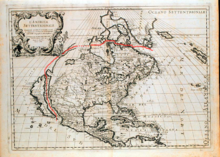Francisco de Ulloa
Francisco de Ulloa († 1540 ) was a Spanish explorer who explored the west coast of today's Mexico on behalf of Hernán Cortés . The reports of his travels along Lower California contributed significantly to the persistence of the 17th century misconception that California was an island.
To this day it is not known whether Ulloa accompanied Cortés on his first expedition to New Spain . According to Díaz del Castillo's report , he came to Mexico only later to deliver Corté's letters from his wife. However, according to the records of some early historians, he had participated in the conquest of the Aztec capital Tenochtitlán , now Mexico City , by ship.
In 1539, at Cortés' private expense, he began a small three-ship expedition from Acapulco to the north. He wanted to explore the Pacific coast and look for the mysterious Strait of Anián , which would provide a water link to the Gulf of Saint Lawrence and thus part of the Northwest Passage . About six weeks after leaving on July 8th, he reached the Gulf of California , which he named the Sea of Cortés after his client . This name is still common today (English Sea of Cortés , Spanish Mar de Cortés ). After losing one of his ships, the Santo Tomás , in a storm, he interrupted the voyage to repair the other two. Eventually he resumed exploration on September 12th and finally reached the northern end of the gulf.
When he could not find the Strait of Anián there, he sailed south on the east coast of Baja California to the Bay of La Paz , where he had the food supplies replenished for his crew. After that he circled the tip of the peninsula with great difficulty and gave the order to sail further north.
The movement of the small ships was made difficult by strong winds and high seas, so that he was forced to return to New Spain at about the level of Isla de Cedros , which is at 28 ° north latitude .
Although his discoveries supported the fact that Baja California is only a peninsula , his records were used to draw maps showing Baja California as a real island. According to Díaz del Castillo, when Ulloa returned in 1540, he was stabbed to death by another sailor. Other sources report that the two ships, the Santa Agueda and the Trinidad , were lost on the return voyage from Baja California.
| personal data | |
|---|---|
| SURNAME | Ulloa, Francisco de |
| BRIEF DESCRIPTION | Spanish explorer, explored the west coast of what is now Mexico |
| DATE OF BIRTH | 15th century or 16th century |
| DATE OF DEATH | 1540 |

